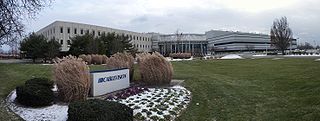
Comcast Corporation, formerly known as Comcast Holdings, is an American multinational telecommunications and media conglomerate incorporated and headquartered in Philadelphia.

Rouzbeh Yassini, known as the "Father of the Cable Modem", is an Iranian-American inventor, engineer, and author, who has gained international reputation as a "broadband visionary" for his pioneering work in broadband industry and inventing the cable modem, establishing the cable modem industry standards (DOCSIS) through Cable Television Laboratories (CableLabs), the Society of Cable Telecommunications Engineers (SCTE) and the International Telecommunication Union (ITU). He is executive director of the University Of New Hampshire Broadband Center Of Excellence and Founder and board member of the YAS Foundation. Yassini is the author of “Planet Broadband”, a humanized look at broadband technology and its contributions to the society, as well as “Broadband Intelligent Series”, a series of white papers on digital services. He is a worldwide speaker and is often interviewed and quoted in the press for his vision on the future of broadband. His lifetime vision and dream is that all the people in the world have ubiquitous access to the broadband and be connected all the time. He believes that broadband connectivity is a fundamental right for all the human beings, what he has referred to it frequently as "Broadband Equality". Yassini was founder, CEO, and president of LANcity, the early pioneer in cable modems. He has worked with Cable Television Laboratories, Inc. (CableLabs) a research arm of the cable television industry in charge of the DOCSIS and on CableHome projects as the cable industry's point man on standardizing the cable modem's global footprint. He served as a senior executive consultant to the cable industry's CEOs while being president and CEO of YAS Corporation. He also has worked with Comcast and Cablevision on numerous programs relating to innovation of broadband technologies. From 2004 to 2007, Yassini worked with the CTO's office at Comcast to create the first industry standard IP-Set top Box specification known as the RNG specification. He has been involved in managing and advising companies ranging from $100 million to $50 billion and served as member of the board of directors on BAS, TrueChat, and Entropic from 2001 to 2008, and UPC Technical Advisory Committee. He created and chaired the Vendor and Operator Executive Advisory Forum of the U.S. Cable Center. He was a member of the Liberty Global Inc. (LGI) advisory technology board from 2001 to 2017. Yassini was director of Visteon from January 2015 to December 2020. As CEO and Chairman of Irystec, a Montreal-based firm founded in 2015 specializing in perceptual display processing technology, Yassini was able to successfully have the french auto company Faurecia acquire the company in 2020, despite the Covid pandemic. Working for more than 30 years in the broadband industry and achieving major accomplishments, Yassini received many awards from different organizations. In 2024, he received Technology & Engineering Emmy® Award, from the National Academy of Television Arts & Sciences. In the same year, he was inducted to the Cable Hall of Fame. He also was inducted to the Light Reading Hall of Fame, in 2019. He was named multiple times as CED Broadband 50 designate. CED Magazine named him “1998 Man of the Year” for creating and fostering the multibillion-dollar cable modem broadband industry. The National Cable & Telecommunications Association (NCTA) awarded Yassini with a 2004 Vanguard Award, the Cable Industry's highest honor in recognition of his contributions and dedication to the industry. The Cable Television Pioneers also inducted Yassini into the class of 2012 for his tremendous and meaningful contributions to the cable industry. He is a member of the Lane Department Academy as well as West Virginia University Academy of Distinguished Alumni.
US West, Inc. was one of seven Regional Bell Operating Companies, created in 1983 under the Modification of Final Judgement, a case related to the antitrust breakup of AT&T. US West provided local telephone and intraLATA long-distance services, data transmission services, cable television services, wireless communications services and related telecommunications products to defined areas in Arizona, Colorado, Idaho, Iowa, Minnesota, Montana, Nebraska, New Mexico, North Dakota, Oregon, South Dakota, Utah, Washington, and Wyoming. US West was a public company traded on the New York Stock Exchange under the ticker symbol "USW" with headquarters at 1801 California Street in Denver, Colorado.

Shaw Communications Inc. was a Canadian telecommunications company which provided telephone, Internet, television, and mobile services. The company was founded in 1966 as Capital Cable Television Company, Ltd. by JR Shaw in Edmonton. The company was acquired by and amalgamated into Rogers Communications in 2023; most operations were rebranded to the Rogers brand beginning in July of that year, with services and sponsorships in former Shaw markets having used the transitional brand Rogers together with Shaw for promotional purposes.

Tele-Communications, Inc. (TCI) was a cable television provider in the United States, and for most of its history was controlled by Bob Magness and John Malone.

Altice USA, Inc., commonly known as Altice, is an American telecommunications provider with headquarters in New York City, owned by the Franco-Israeli businessman Patrick Drahi. The company delivers pay television, Internet access, telephone services, and original television content to approximately 4.9 million residential and business customers in 21 U.S. states. Altice USA is based at One Court Square in Long Island City, Queens, New York City. The company's operational center is located at Cablevision's former headquarters in Bethpage, Nassau County, New York, on Long Island. With its combined brands, Altice USA is the fourth-largest cable provider in the U.S., serving customers residing in the New York metropolitan area as well as in several Midwestern and Southern U.S. states.

Charter Communications, Inc., is an American telecommunications and mass media company with services branded as Spectrum. The company is headquartered in Stamford, Connecticut.

Scientific Atlanta, Inc. was a Georgia, United States–based manufacturer of cable television, telecommunications, and broadband equipment. Scientific Atlanta was founded in 1951 by a group of engineers from the Georgia Institute of Technology, and was purchased by Cisco Systems in 2005 for $6.9 billion after Cisco received antitrust clearance for the purchase. The Cisco acquisition of Scientific Atlanta was ranked in the top 10 of largest technology acquisitions in history and was Cisco's largest acquisition to date. Prior to the purchase, Scientific Atlanta had been a Fortune 500 company and was one of the top 25 largest corporations in Georgia.

Comcast Cable Communications, LLC, doing business as Xfinity, is an American telecommunications business segment and division of the Comcast Corporation. It is used to market consumer cable television, internet, telephone, and wireless services provided by the company. The brand was first introduced in 2010; prior to that, these services were marketed primarily under the Comcast name.

Time Warner Cable, Inc. (TWC) was an American cable television company. Before it was acquired by Charter Communications on May 18, 2016, it was ranked the second largest cable company in the United States by revenue behind only Comcast, operating in 29 states. Its corporate headquarters were located in the Time Warner Center in Midtown Manhattan, New York City, with other corporate offices in Stamford, Connecticut; Charlotte, North Carolina; and Herndon, Virginia.
King Videocable was a broadcast cable television company based in Seattle, Washington. It was owned by the King Broadcasting Company, then-owners of Seattle television station KING-TV, and by investment firm Kelso and Company. Launched in the early 1970s by King Broadcasting employee Edward Hewson, it eventually expanded to cover around 500,000 customers, with systems stretching from Los Angeles to Minneapolis.

Windstream Holdings, Inc., also doing business as Windstream Communications is a provider of voice and data network communications, and managed services, to businesses in the United States. The company also offers residential broadband, phone and digital streaming TV services to consumers within its coverage area. It is the ninth largest residential telephone provider in the country with service covering more than 8.1 million people in 21 states.

RCN Corporation, originally Residential Communications Network, founded in 1993 and based in Princeton, New Jersey, was the first American facilities-based ("overbuild") provider of bundled cable telephony, cable television, and internet service delivered over its own hybrid fiber-coaxial local network as well as dialup and DSL Internet service to consumers in the Boston, Chicago, Los Angeles, New York City, the Lehigh Valley in eastern Pennsylvania, and Washington, D.C. areas.

Breezeline is the trade name for the United States operations of Cogeco Communications, constituting the 8th largest cable operator in the United States, based on the number of television service customers served. The company currently provides TV, Internet and phone services using a combined coaxial cable & fiber-to-the-premises (FTTP) network. Breezeline currently has approximately 707,000 broadband customers located in thirteen states. The company is headquartered in Quincy, Massachusetts.
Bresnan Communications was an American cable television provider formed by William Bresnan in 1984. It originally operated cable systems on Michigan's Upper Peninsula. Over the next fourteen years, its operations spread to Minnesota Wisconsin, Mississippi and Georgia. In 1994, the company added international operations in Chile and Poland, with the creation of Bresnan International Partners. The company reached 400,000 subscribers after purchasing systems from TCI. When AT&T acquired TCI, Bresnan began to consider an IPO. Before that could occur, Paul Allen's Charter Communications made an offer, and purchased Bresnan's U.S. cable systems for $3.1 billion, organizing them under Charter Communications' umbrella.
The history of AT&T dates back to the invention of the telephone. The Bell Telephone Company was established in 1877 by Alexander Graham Bell, who obtained the first US patent for the telephone, and his father-in-law, Gardiner Greene Hubbard. Bell and Hubbard also established American Telephone and Telegraph Company in 1885, which acquired the Bell Telephone Company and became the primary telephone company in the United States. This company maintained an effective monopoly on local telephone service in the United States until anti-trust regulators agreed to allow AT&T to retain Western Electric and enter general trades computer manufacture and sales in return for its offer to split the Bell System by divesting itself of ownership of the Bell Operating Companies in 1982.

Comcast Business is a subsidiary of Comcast, which, through several iterations, has handled the sales, marketing, and delivery of internet, phone, and cable television to businesses. In 2012, Comcast Business grew by 34%, the fastest growth of any of Comcast's products in 2012, reaching $2.4 billion in revenue. In 2013, Comcast Business generated $3.2 billion in revenue, an increase of 26% over 2012 revenue.

David Fellows is an American engineer, entrepreneur, and scientist. He is the co-founder and chief technology officer of Layer3 TV, and served previously as the chief technology officer for Comcast and AT&T Broadband.

Cablevision Systems Corporation was an American cable television company with systems serving areas surrounding New York City. It was the fifth-largest cable provider and ninth-largest television provider in the United States. Throughout its existence and in its final years, Cablevision exclusively served customers residing in New York, New Jersey, Connecticut, and a small part of Pennsylvania. However, at one time it provided service in as many as 19 states. Cablevision also offered high-speed Internet connections, digital cable, and VoIP phone service through its Optimum brand name. Cablevision also offered a WiFi-only mobile phone service dubbed Freewheel.
Optimum is an American telecommunications brand owned and operated by Altice USA. It is the fourth largest cable provider in the United States and a Fortune 500 company. Optimum offers Internet, television, mobile and home phone serving in 17 states.














